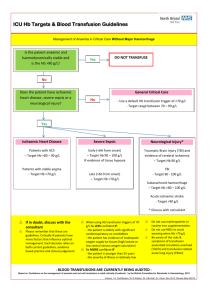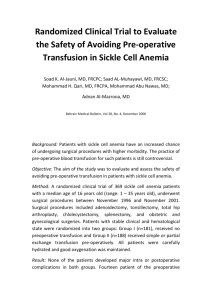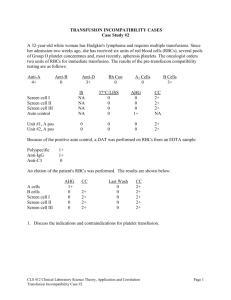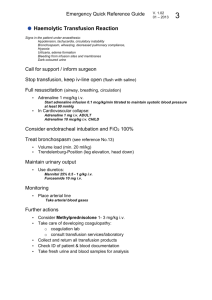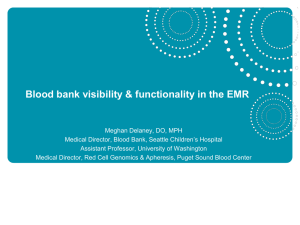miniPIERS Maternal Outcomes- full definitions - PRE-EMPT
advertisement
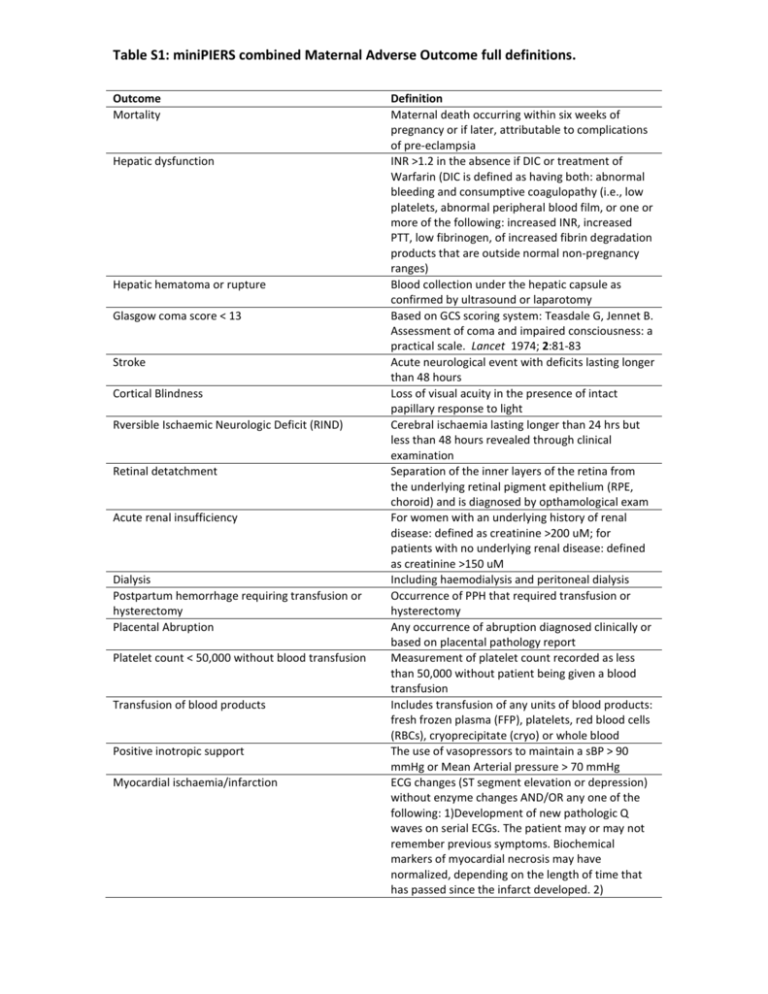
Table S1: miniPIERS combined Maternal Adverse Outcome full definitions. Outcome Mortality Hepatic dysfunction Hepatic hematoma or rupture Glasgow coma score < 13 Stroke Cortical Blindness Rversible Ischaemic Neurologic Deficit (RIND) Retinal detatchment Acute renal insufficiency Dialysis Postpartum hemorrhage requiring transfusion or hysterectomy Placental Abruption Platelet count < 50,000 without blood transfusion Transfusion of blood products Positive inotropic support Myocardial ischaemia/infarction Definition Maternal death occurring within six weeks of pregnancy or if later, attributable to complications of pre-eclampsia INR >1.2 in the absence if DIC or treatment of Warfarin (DIC is defined as having both: abnormal bleeding and consumptive coagulopathy (i.e., low platelets, abnormal peripheral blood film, or one or more of the following: increased INR, increased PTT, low fibrinogen, of increased fibrin degradation products that are outside normal non-pregnancy ranges) Blood collection under the hepatic capsule as confirmed by ultrasound or laparotomy Based on GCS scoring system: Teasdale G, Jennet B. Assessment of coma and impaired consciousness: a practical scale. Lancet 1974; 2:81-83 Acute neurological event with deficits lasting longer than 48 hours Loss of visual acuity in the presence of intact papillary response to light Cerebral ischaemia lasting longer than 24 hrs but less than 48 hours revealed through clinical examination Separation of the inner layers of the retina from the underlying retinal pigment epithelium (RPE, choroid) and is diagnosed by opthamological exam For women with an underlying history of renal disease: defined as creatinine >200 uM; for patients with no underlying renal disease: defined as creatinine >150 uM Including haemodialysis and peritoneal dialysis Occurrence of PPH that required transfusion or hysterectomy Any occurrence of abruption diagnosed clinically or based on placental pathology report Measurement of platelet count recorded as less than 50,000 without patient being given a blood transfusion Includes transfusion of any units of blood products: fresh frozen plasma (FFP), platelets, red blood cells (RBCs), cryoprecipitate (cryo) or whole blood The use of vasopressors to maintain a sBP > 90 mmHg or Mean Arterial pressure > 70 mmHg ECG changes (ST segment elevation or depression) without enzyme changes AND/OR any one of the following: 1)Development of new pathologic Q waves on serial ECGs. The patient may or may not remember previous symptoms. Biochemical markers of myocardial necrosis may have normalized, depending on the length of time that has passed since the infarct developed. 2) Eclampsia Require >50% oxygen for greater than one hour Intubation other than for Cesarean section Severe breathing difficulty Pulmonary Oedema Pathological findings of an acute, healed or healing MI 3) Typical rise and gradual fall (troponin) or more rapid rise and fall (CK-MB) of biochemical markers of myocardial necrosis with at least one of the following: a) ischaemic symptoms; b) development of pathologic Q waves on the ECG; c) ECG changes indicative of ischaemia (ST segment elevation or depression); or d) coronary artery intervention (e.g., coronary angioplasty) Any episode of seizure antepartum, intrapartum or before postpartum discharge as follow-up beyond discharge is not possible Oxygen given at greater than 50% concentration based on local criteria for longer than 1 hour Intubation may be by ventilation, EIT or CPAP Suspected pulmonary oedema where x-ray confirmation unavailable may be diagnosed by presence of chest pain or dyspnoea, crackles in the lungs and SaO2 <90% Clinical diagnosis with x-ray confirmation or requirement of diuretic treatment and SaO2 <95%
